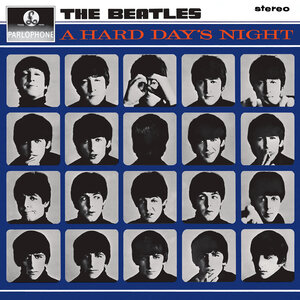This is an old revision of this page, as edited by Scraggy4 (talk | contribs) at 13:03, 9 May 2004 (added UK track length). The present address (URL) is a permanent link to this revision, which may differ significantly from the current revision.
Revision as of 13:03, 9 May 2004 by Scraggy4 (talk | contribs) (added UK track length)(diff) ← Previous revision | Latest revision (diff) | Newer revision → (diff)| A Hard Day's Night | ||
|---|---|---|

| ||
| LP by The Beatles | ||
| Released | US-June 26 1964, UK-July 10 1964 | |
| Recorded | Abbey Road Studios 1964 | |
| Genre | Rock | |
| Length | US-29 min 21 sec, UK-30 min 28 sec | |
| Record label | US-United Artists, UK-Parlophone | |
| Producer | George Martin | |
| Professional reviews | ||
| Q | 4 stars out of 5 | November 2000 |
| Allmusic.com | 3 stars out of 5 | link |
| The Beatles Chronology | ||
| With the Beatles (November 1963) |
A Hard Day's Night (June/July 1964) |
Beatles for Sale (November 1964) |
A Hard Day's Night was The Beatles' third album, released in 1964 as the soundtrack to their first film of the same name. All songs are composed by John Lennon and Paul McCartney.
The album , whilst showcasing the development of the band's songwriting talents, sticks to the basic rock and roll instrumentation and song format. Some of the more notable songs on the album include the title track (with its distinct, instantly recognizable opening chord), and the catchy "Can't Buy Me Love". It also features "And I Love Her", the first of what would become many popular McCartney ballads.
The United States version of the album was released on June 26, 1964 by United Artists and contained the seven songs from the film ("A Hard Day's Night", "Tell Me Why", "I'm Happy Just To Dance With You", "I Should Have Known Better", "If I Fell", "And I Love Her", "Can't Buy Me Love"), plus "I'll Cry Instead." The U.S. version also included four instrumental versions of Lennon and McCartney songs by George Martin. ("I Should Have Known Better" (instrumental), "And I Love Her" (instrumental), "Ringo's Theme (This Boy)" (instrumental) and "A Hard Day's Night" (instrumental).)
The title of the album (and film) was the accidental creation of drummer Ringo Starr. The band had begun filming the motion picture while it was still without a title. After one particularly rough day of shooting, Starr emerged from the studio (thinking it was still daytime) and said "It's been a hard day..." (noticing that it was now dark outside) "...'s night."
Released by EMI Records, produced by George Martin.
- "A Hard Day's Night" SAMPLE (104k)
- "I Should Have Known Better"
- "If I Fell"
- "I'm Happy Just to Dance With You"
- "And I Love Her" SAMPLE (163k)
- "Tell Me Why"
- "Can't Buy Me Love" SAMPLE (121k)
- "Any Time At All"
- "I'll Cry Instead"
- "Things We Said Today"
- "When I Get Home"
- "You Can't Do That"
- "I'll Be Back"
(The Track Listing is from the CD Release. This album was originally released on LP.)
Peter Sellers recorded a comedy version of the song "A Hard Day's Night", in which he chanted the lyrics in the style of Laurence Olivier as Shakespeare's Richard III.
The film A Hard Day's Night was written by Alun Owen. It chronicled in a mock documentary-style the Beatles arriving at a theater, rehearsing, and finally performing in a television special. Owen spent several days with the group, who told him their lives were like "a room and a car and a room and a car and a room and car". He realized that by 1964 the Beatles were prisoners of their own fame, and that their schedule of performances and studio work by that time was extremely punishing, and wrote that into the script. The film was shot in black and white in the spring of 1964, and remains the definitive documentary of Beatle-mania. In various places, the Beatles comment cheekily on their own fame: for instance, at one point a fan takes John Lennon for John Lennon; he demurs, saying that his face isn't quite right. The fan agrees.
New York Times film critic Bosely Crowther noted that the film is also a subtle satire on the image of rock-and-roll music (and the Beatles in particular) as a source of youth rebellion and defiance of authority. In the film, the Beatles are portrayed as likable young lads who are constantly amazed at the attention they receive and who want nothing more than run around and have a good time; however, they have to deal with screaming crowds, idiot journalists who ask nonsense questions, and authority figures who constantly look down upon them. The biggest troublemaker in the film is an elderly senior citizen, Paul McCartney's "clean" grandfather (played by Wilfred Brambell).
Many see the film as playing a major role in development of modern music videos, especially the "Can't Buy Me Love" segment, which featured creative camera work, and the band running and jumping around in a field.
The film's director, Richard Lester, also directed the Beatles' next film, Help!. He went on to direct several popular motion pictures of the 1970s and 1980s, including The Three Musketeers and Superman II.
Two extras in this film would become famous in their own right. Phil Collins was an extra in the concert sequence and later became the drummer in the group Genesis. Patricia Boyd later married both George Harrison and Eric Clapton.